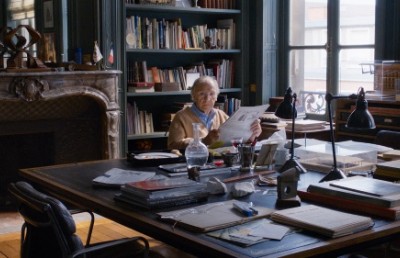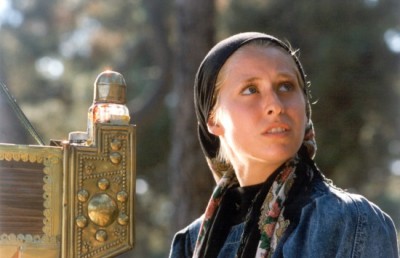Faith, Knowledge, Illness, Sacrifice: Stephen and Jane Hawking in the film The Theory of Everything

“A theory is a good theory if it satisfies two requirements: It must accurately describe a large class of observations on the basis of a model that contains only a few arbitrary elements, and it must make definite predictions about the results of future observations,” remarked the scientist Stephen Hawking in his introduction to his popular book A Brief History of Time: From the Big Bang to Black Holes (Bantam Books, 1988; page 9). In the book A Brief History of Time, Stephen Hawking provides history of science and theory, acknowledges the contribution of others, and is not afraid to allude to daily life in ways that are honest, intimate, difficult, and funny: it is a work—dedicated to his wife Jane—with chapters that address space and time, the expanding universe, the uncertainty principle, elementary particles, black holes, and the possibility of a theory that will connect the large and small aspects of physics. Stephen Hawking has endeavored to arrive at a theory that would bring together the established understandings of large scale structures of the universe and the small scale or the level of atoms, reconciling the theory of relativity, with its understanding of space, time, gravity, and light, and quantum mechanics. “Our modern picture of the universe dates back to only 1924, when the American astronomer Edwin Hubble demonstrated that ours was not the only galaxy. There were in fact many others, with vast tracts of empty space between them,” Hawking reminds us, his readers and fellow sharers of the planet (page 36). Edwin Hubble estimated the size of the Milky Way galaxy by establishing the brightness of stars, and the distance of one star to another (stars glow with a spectrum of colors, blue being hotter than red; and their light moves in waves, measured by frequency and speed), with Hubble figuring out the distances to nine different galaxies. Our galaxy now is one of “some hundred thousand million” that can be observed by telescope, asserts Stephen Hawking (page 37). The universe—full of galaxies, planets, stars, and dark matter—is expanding. Will it stop expanding? That would depend on the rate of expansion and the density of the universe, Hawking informs us (page 45). Stephen Hawking thinks the universe—for millions of years— will continue to expand.
Knowledge is an ideal, an accomplishment, the result of discipline, energy, and thought. Each of us has to find the culture, knowledge, and practices—the arts, philosophy, sciences, civic rituals, political solutions, and social relationships—that will enrich our private and public lives. There are exemplary figures in most human endeavors: as a scientist, Stephen Hawking is one such figure. James Marsh’s film of the career and marriage of Stephen Hawking, The Theory of Everything (2014), with cinematography by Benoît Delhomme, and edited by Jinx Godfrey, is more colorful, more dramatic, and more suggestive than one imagines a biography of a thinker would be. Marsh’s filmography as director includes Wisconsin Death Trip (1999), The King (2005), Man on Write (2008), and Shadow Dancer (2011), the last about the Irish troubles; and The Theory of Everything, distributed by Focus Features, is likely to achieve lasting respect (there are a number of things it might have done better but there are many more things it might have done worse). The film, with a screenplay written by Anthony McCarten, based on Jane Hawking’s book Travelling to Infinity: My Life With Stephen (first published in 1999 as Music to Move the Stars), suggests complexities—of biography and science—it does not make explicit. The British scientist and scholar Stephen Hawking, born in Oxford on the anniversary of Galileo’s death to well-educated and demanding but eccentric parents, was a gifted but indifferent student of science when Stephen learned that he had a serious illness (a disorder of the nerves: amyotrophic lateral sclerosis) that likely would shorten by life—and the fear of death seems to have pushed him into relishing time and making a commitment to accomplishing significant work in his field. His wife Jane Wilde, a scholar of romance languages and medieval poetry, devoted herself to his demanding care. Stephen Hawking wrote, with G.F.R. Ellis the book The Large Scale Structure of Space-Time (1973). Stephen Hawking’s theory about the radiation generated by black holes brought fame within and beyond his science, but his illness worsened and Hawking lost his voice in 1985, though he would benefit from the help of wife, assistants, and a computer speech program. His book A Brief History of Time (1988) brought Hawking more acclaim. Stephen Hawking has been seeking a theory of everything, a theory that would explain the creation of the universe, uniting cosmology with quantum mechanics: quantum mechanics describe and explain nuclear particles of varying positions and velocity.
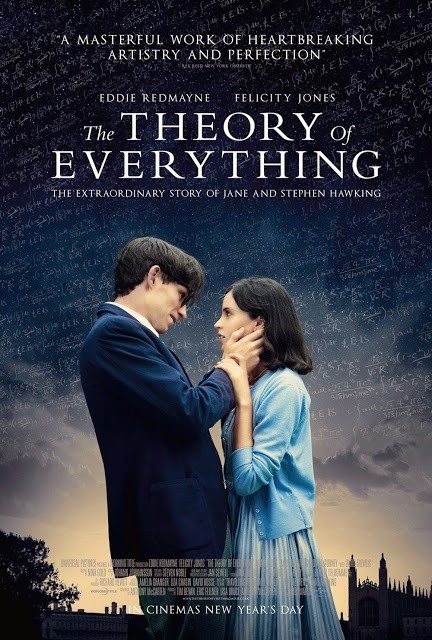
How is a person to move from ignorance to knowledge? How might we better understand self and world? How can we make use of what we have in our attempt to gain what we need if we do not understand the possibilities of what we already possess? How can we work with others if we do not understand them, their hopes, needs, skills, or their weaknesses? How can we seek, find, or sustain joy or serenity if we cannot identify them—or the circumstances that make those desired states likely? The respect for knowledge has to be cultivated. If a child grows up in a house in which knowledge is not cultivated, or respected, he may scoff at things that are complex, difficult, or strange, things that do not offer easy gratification. It is important to learn of things beyond our daily needs, beyond the concern for shelter, food, and comfort; beyond the desire for approval and pleasure. It is important to know the difference between the true and the false, to discern good and evil, and to distinguish the beautiful from the ugly. It is important to understand the human past, if one wants to anticipate or shape the human future. It is important to cultivate knowledge. One cultivates knowledge by being open to what exists, to what inspires the mind and spirit, to art and science and philosophy. One accepts the necessity of discipline, and identifies areas of learning that one wants to master—and begins reading. One finds comrades and friends who share one’s sense of purpose. One makes a commitment to knowledge as an ideal.
Our culture is full of all kinds of works, some intelligent, some dumb; some optimistic, some pessimistic. There are times when we seem to have more of one kind of work than another. Much of the work available is work that is financed simply in the belief that it will make money. The more challenging work is, the smaller the audience. Ignorance is bankable. Two decades ago, the film critic Caryn James, writing in the New York Times (January 8, 1995), noted a spate of contemporary films —Nell, I.Q. and Forrest Gump —that affirmed dumbness as virtue, as well the antecedents of those films such from The Three Stooges and Beavis and Butthead: “Nell, I.Q. and Forrest Gump are breezy and enjoyable, with vast amounts of surface charm. But underneath, they are chilling in the way they link virtue with lack of intelligence. It is a theme that goes far beyond coincidence. Both Nell and I.Q were planned long before Forrest Gump became a catchword for holy innocence, so the newer films are not clones. Instead, they suggest a virulent anti-intellectualism in the air.” Caryn James recalled Richard Hofstadter’s 1963 book Anti-Intellectualism in American Life, which identified the significant —practical, political, and spiritual— antagonism to intellect in American culture. Today, decades later, when many of the most popular films are based on comic strips or old television shows and hesitate to engage serious ideas and issues, those who love cinema and thoughtful art suffer another frustrating moment.
In part due to land resources, frontier spirit, growing industries, and the devastating circumstances of war abroad, the Unites States of America may have become an intellectual leader in the twentieth century, the American century, but the nation has been faltering discernibly: where it had been number one, it has been falling behind other nations in various surveys of education. Mastery of math and science are not what they used to be—and there is much indifference to knowing the culture and history of other nations. Richard Hofstadter’s Anti-Intellectualism in American Life was not the last book to try to analyze the hostile, instinctive American sensibility. Various books have attempted to diagnose the repudiation of reason and knowledge in American life and politics. Al Gore’s The Assault on Reason (2007) was one book, and it focused on the media age and politics, in which facts and science are dismissed on behalf of fear and ideology. Susan Jacoby’s The Age of American Unreason (2008) focused on a culture of distraction, of immaturity and image, of religion and rage, of rock and rap—with the glorification of self-esteem replacing awareness of the necessity of self-improvement, and the educated teacher being replaced by the self-authorized provincial. As does Susan Jacoby, Mark Bauerlein’s The Dumbest Generation (2008) cites the decline of print culture on behalf of visual mediums as a factor. Mark Bauerlein laments the lack of knowledge of history and literature, of significant ideas—with personal event and gossip and pop culture trash receiving the bulk of attention from young people. Charles Pierce’s Idiot America: How Stupidity Became a Virtue in the Land of the Free (2009) is an examination of the rejection of science and the substitute of religion for fact, and the preference of emotion above intelligence. Catherine Liu’s American Idyll: Academic Antielitism as Cultural Critique (2011) draws attention to the increasingly utilitarian aspects of American education—education as the acquisition of attitudes and skills for acquiring a job, with increased animosity toward genuine expertise from the left (progressive) and the right (conservative) sides of American politics.
Ignorance can be found in each of us, of course—in our past, present, or future. As a child, I loved to read, write, and draw, loved to walk in the woods and observe nature, loved to hear of interesting facts and stories and to imagine, but sometimes I would joke and talk in elementary school classes with friends, rather than pay continued attention to the lessons, and in high school I was glib about the subjects I did not think I needed to know anything about. With time and thought I learned that we cannot anticipate all the different kinds of knowledge that can help us—or the ignorance that can hurt us—and the fact that discipline mastered in one area, even an area in which we do not take a personal interest, can be applied in another area, one for which we may have a passion. Creativity and thought can lead to knowledge, and offer a new vision of self and world—but one has to recognize the limits of the old vision, of the conformist vision. I saw how the misunderstanding and resentment of criticism paralyzed communities, especially minority communities, and how the failure of self-criticism and self-correction perpetuated communal impoverishment, misery, and violence. Often, I have thought of culture, particularly of literature, as the realm of enlightenment, as the bearer of necessary and honest but transcendent thought and feeling: the text of a writer can be conversation or meditation—the text of a writer can be battle, discovery, journey, romance—the text of a writer can be declaration of war or lullaby or prayer—the text of a writer can be a way of being, thinking, saying, doing: a way of living—and, yet, this is a realm that can be seen as merely imaginative, personal, subjective. Science is a realm of fact, problems, equations, possible solutions, experiment, and proof.
Science is speculation and observation. It is practical and imaginative. One of science’s most intriguing topics, probably the most intriguing, has been the origin of the universe, which might have begun with a singularity, the explosion of dense material, a big bang—the kind of singularity (making strange space and time) that scientists identity with stars that become black holes. What are stars? What are black holes? Gravity causes gas—hydrogen and helium—to collapse, and the atoms of gas collide, faster and faster, and grow hotter, increasing the quantity of helium, beginning to glow—becoming stars. The gas pressure balances gravity and becomes stable—for a time, although when a star runs out of fuel it begins to contract or collapse again: if the star is massive and its gravity very strong, no light escapes (its boundary is called the event horizon); and the result is a dark void in space called a black hole, a term first used by John Wheeler, an American scientist, in 1969, explains Stephen Hawking in his book A Brief History of Time (page 81 through 87). Black holes are dense, and time and space within them are difficult to analyze or predict—a singularity (88). Stephen Hawking’s thinking about black holes have been a great part of his fame: scientists had thought that no light or matter could escape black holes, but Hawking argued that heat radiation could escape, an assertion that drew on theoretical aspects of relativity and quantum mechanics; and his renown has made Hawking as scientist and man an attractive subject for film, a visual art that is challenged and expanded by the attempt to make vivid intellectual and spiritual life.
In The Theory of Everything, directed by James Marsh, Eddie Redman appears as Stephen Hawking: Redmayne is impressive and moving. (Redmayne is an actor I have seen in other things —Les Miserables, The Pillars of the Earth —without being pleased: he seemed freakish to me.) The biographical film features Felicity Jones as Jane Wilde, a student and teacher of romance languages who will become Stephen Hawking’s wife. Jane was a Christian, and Stephen an atheist. Charlie Cox is musician and choirmaster Jonathan Hellyer Jones, who becomes a helper to Stephen and companion to Jane. Emily Watson is Beryl Wilde, Jane’s mother, and Simon McBurney is Frank Hawking, Stephen’s father. David Thewlis is Dennis Sciama, a college professor and supporter of Stephen Hawking. It is, very obviously, a small but strong cast, and that is necessary for a film that attempts to bring us closer to a world that assumes or creates appearances, perceptible phenomena, but compels us to look beneath and beyond what is apparent to a world of experimentation, logic, and proof. Yet, the motion picture is not abstract or dry. It asks us to recognize that logic and love, like fact and faith, can share the same bed. It can be difficult to make a film that respects the elemental subjects of math and science, though people continue to try: and among the admirable attempts —some devoted to fact, others to fantasy— are A Beautiful Mind, about the gifted mathematics scholar who suffered from paranoid schizophrenia, and Apollo 13, Awakenings, Children of Men, Dark City, Enigma, Finding Nemo, Gattaca, Inherit the Wind, Life Story, Lorenzo’s Oil, Madame Curie, Metropolis, Moneyball, October Sky, Proof, Soylent Green, 2001: A Space Odyssey, and The Story of Pasteur.
The motion picture biography of Stephen Hawking is a portrait of a brilliant mind defying a weakened body, of compromised movement in a world of movements. The film begins at Oxford, in a setting of privilege and promise, though the young Stephen Hawking (Eddie Redmayne) was capable but lazy, doing no more than an hour of work a day. In The Theory of Everything, Stephen Hawking (Redmayne) meets Jane Wilde (Felicity Jones) and they charm each other, though their sensibilities or orientations are different: science (cosmology) and atheism on one hand, and the arts (languages and poetry) and religious faith on the other. Hawking discloses to Jane that he would like to identify a unifying theory of the universe. Beneath their conversation is the music of performers such as Martha and the Vandellas, and Dinah Washington (performers whose sounds suggest a different kind of experience entirely: grittier, more struggling, and more triumphant for being less predictable than that of the English haute bourgeoisie). Stephen Hawking preferred the grandly complex music of the classical composer Wagner, music that matched Hawking’s vision of the world.
Stephen Hawking (Redmayne) is shown the science lab in which the atom was split, an important scene of discovery, of accomplishment; and it is clear that there are large expectations for what the gifted Hawking might do in science. His professor—Dennis Sciama (David Thewlis)—tells Hawking that one never knows the source of the next great discovery. The friendship with Jane Wilde (Felicity Jones) grows and Jane meets Stephen’s frisky family, and goes with him to a ball that is elegant fun, full of cheer, light, and movement (Stephen notes that a certain detergent helps the men’s shirts to glow). Jane recites poetry and lines from the Christian bible. Jane is petite, pretty, and practical, as well as poetic, a figure of faith and force. Stephen speaks of dying stars that emit radiation; and they observe fireworks, and then a night sky full of shining stars. Little awkward movements and accidents (his curled fingers, dropped pens and cups, difficult walking, and stiff dancing) suggest the growing aggregation of trouble in Hawking’s body.
Stephen Hawking is invited by Professor Sciama (Thewlis) to attend a talk by Roger Penrose on the nature of black holes: Roger Penrose (Christian McKay) says that matter is crushed inside of a black hole, with nothing escaping. Following the talk, Hawking thinks about time and the expanding of the universe; and Hawking imagines the reversal of that expansion—the shrinking of the universe, going back in time to the beginning of the universe. Professor Sciama tells Hawking to develop the math that would embody his thinking, an admonition that inspires Hawking’s excited work—but, one day, when Hawking is walking across campus he falls, injuring himself, and begins a number of medical tests. Hawking is told that the brain signals that the muscles must receive are disrupted in him; and he is told that his brain will remain active but that he will lose the power of speech, and he is given a prognosis of two years left to live.
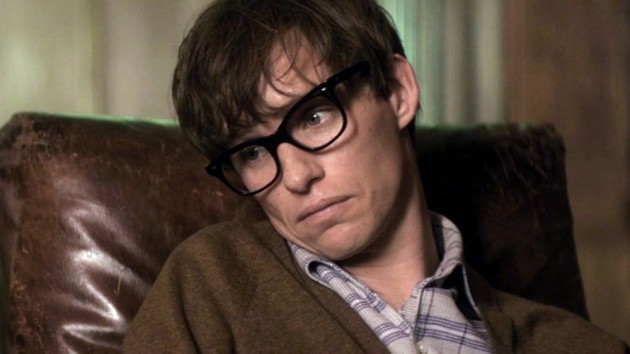
Hawking, with his legs crippled, tries to withdraw from friends, including Jane (she visits the tormented young man in a room with red curtains, giving the room a fiery aspect, hellish)—but his friends do not allow his disappearance from their lives. They have seen his value—to them, and to the world. Jane begins to demonstrate her concern and faith; she, despite his family’s discouragement, challenges Stephen and declares her love. Stephen and Jane marry (the wedding is shown in sixteen millimeter, like a home movie; part of the shifting imagery in this film of beauty and care and restraint).
Hawking writes on the beginning of time and black holes, and he faces his doctoral committee, three respected professors who tell him that the first three chapters of his thesis are flawed but the fourth is brilliant—and he receives his degree. It is a small conveyance of the unique commitment and camaraderie possible in an academic environment. The essential value of a unique contribution is affirmed. A celebratory meal is held at home with Stephen and Jane’s friends, but this brilliant man, Stephen Hawking, his fingers twisted, barely can manage to eat his dinner (he leaves the dining table to go upstairs—and begins to crawl the steps). Soon, Jane is bringing in a wheelchair for Stephen to use. There is a warmth to the light in the film that makes its images pleasant—welcoming, soothing—despite painful events.
Jane Wilde Hawking’s commitment to her husband and family made his work possible. She attended to the kind of practical needs we all have—and to the special needs that this particular man had. It was an example of admirable character and significant faith. When Stephen Hawking presents his idea about radiation emanating from black holes—a new idea—to a small international conference, asserting that stars disappear into black holes, which glow with heat radiation, before black holes themselves disappear, Jane is there in the back of the room, unseen by most people. The new idea is dismissed by some but acclaimed by others. Stephen Hawking becomes famous. Jane Hawking gets exhausted (she finds it hard to get her own work done).
Jane Hawking’s mother recommends that Jane join the church choir, which Jane identifies as a very English recommendation. The recommendation is funny and sweet, and useful. Jane meets the choirmaster, Jonathan (Charlie Cox), an intelligent, sensitive man who nursed his wife until her death and feels a bit lost and is willing to help Jane and Stephen. It is difficult to imagine that people without religious or spiritual faith would be as giving—and would find giving as natural, as full of virtue, as Jonathan and Jane do. (It is easy to be skeptical about the faith of others—whether that faith is artistic, intellectual, spiritual, or political: until one sees the important and necessary things that faith can accomplish.) Jonathan (Cox) is a man of tenderness—it is a rare sight. He is also handsome, making him a temptation. The scenes with Jonathan and the Hawking family—on the beach, in a boat, and at home—are lovely. Jonathan becomes a part of the family—which is a bit suspicious to others. When Stephen takes a flight to the Bordeaux Opera, Stephen suggests that Jane and Jonathan take the car and go camping with the children then meet Stephen in Bordeaux. It is a moment of transcendence, one that cannot last, of course (Stephen becomes ill with pneumonia and has a tracheotomy).
One of the fascinating things about the film is its flirtation with transgression—but, possibly because of British tact, the transgression does not look or feel like transgression. The attraction of Jane and Jonathan has friendly, spiritual, and practical roots, and so does not feel low—it is not mere lust: it is an understandable complication. And when Stephen Hawking allows the closeness of his wife with Jonathan (an invitation Stephen issues to Jonathan in church), it is akin to a blessing. What might have been transgression appears as transcendence of the limited norms of bourgeois life. However, when Stephen gets a new nurse, Elaine, a sensual, smart, funny nurse, it is as if another part of the world has entered their lives. Elaine brings something admiring and flirtatious to Stephen, something sensual and subversive—and her closeness to Stephen causes pain and separation for Jane but it does not seem wrong. (The lack of moralism—without regard to religious belief—can appear radical.) The practicality of marriage drains the relationship of two people of romance, and most people need romance—not romance as a lie but romance as idealization, excitement, possibility. Stephen Hawking needed discovery in both his personal and professional lives. The film The Theory of Everything is, in many ways, about the necessity of arousing, sustaining, and fulfilling different kinds of curiosity.
In the February 9th 2015 issue of the English newspaper The Independent, Geoffrey Macnab praised the lead performances of Redmayne and Jones in The Theory of Everything. Macnab noted the film’s insistence on cheer and triumph, and complimented the evident craft in Theory of Everything: “Director Marsh shoots The Theory of Everything in fluid, fast moving style. Whether showing Hawking working out complex equations at the blackboard or riding on a fairground carousel with Jane, he never lets the narrative tempo drop. Cinematographer Benoît Delhomme uses natural light and handheld camera, managing to make scenes set in very familiar surroundings (Cambridge courtyards and lecture halls, rustic British pubs) seem fresh and invigorating.” The film is an achievement for British cinema, which has for the last several decades been giving us portraits of a land and culture that go beyond the lasting expectations of prestige and propriety, with recent works such as The Imitation Game, about the math genius who created a machine that deciphered Nazi codes but himself fell victim to anti-homosexuality laws, and Belle, in which the British heritage film is integrated with a story about a mulatto girl as heiress, and Black Sea, The English Patient, Four Weddings and A Funeral, The Full Monty, How I Live Now, Hunger, In Bruges, The King’s Speech, My Beautiful Laundrette, Naked, Never Let Me Go, Philomena, Pride, The Queen, The Railway Man, Secrets & Lies, Sexy Beast, Shaun of the Dead, Slumdog Millionaire, This is England, Trainspotting, Under the Sea, When Did You Last See Your Father?, Withnail and I, and Wuthering Heights. Many film viewers are impressed by the charm, intelligence, significance, and variety of themes.
Of course, dissent exists, in general and in particular: different observers see phenomena according to their own views and standards. In the February 23, 2015 issue of the Telegraph in London, Tim Robey wrote of The Theory of Everything, “Anthony McCarten’s script, adapted from Jane’s memoir, Travelling to Infinity, is a thing of undeniable restraint and tact and tastefulness, but it does leave rather a lot of questions unraised, let alone answered. Did they never fight? Was sex at all difficult? What was his work ethic like?” However, the film shows a fight when Stephen tries to withdraw from Jane early in his illness, and later when she is talking about the difficulty of managing family life; and it has Stephen explain to a friend that his sexual equipment performs rather automatically, despite his illness (one assumes his wife was an active partner); and we see Stephen at the blackboard writing equations and subsequently typing into his computer notes on science for a book, and Jane quotes from something Stephen has written that indicates the recognized possibility of divinity. Tim Robey suggested that the film The Theory of Everything lacked the complex torment of a creative or scientific mind.
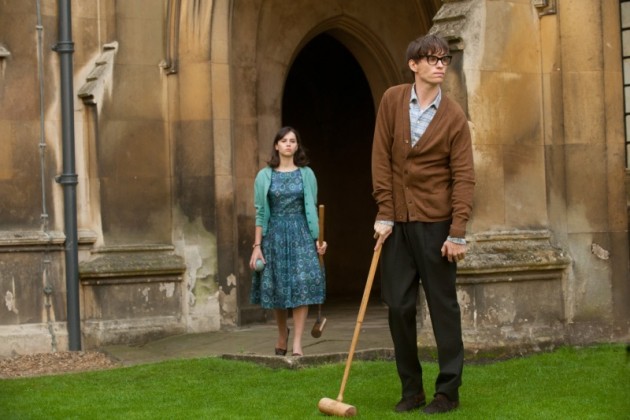
In an October 2014 New York Times article that praised Eddie Redmayne, the writer Dennis Overbye took issue with The Theory of Everything’s presentation of science: “The movie doesn’t deserve any prizes for its drive-by muddling of Dr. Hawking’s scientific work, leaving viewers in the dark about exactly why he is so famous. Instead of showing how he undermined traditional notions of space and time, it panders to religious sensibilities about what his work does or does not say about the existence of God, which in fact is very little.” Stephen Hawking in his book A Brief History of Time notes that “Before 1915, space and time were thought of as a fixed arena in which events took place, but which was not affected by what happened in it” (page 33), but that subsequently thinking about space and time has changed: “Space and time are now dynamic quantities: when a body moves, or a force acts, it affects the curvature of space and time—and in turn the structure of space-time affects the way in which bodies move and forces act. Space and time not only affect but also are affected by everything that happens in the universe,” Hawking stated (33). Times writer Dennis Overbye also complained that the film has characters discuss black holes before the phrase was introduced, and presents a working fireplace as inspiration for an idea about black hole radiation when, in fact, Hawking’s theory involved a theoretical leap—suggested by the work of others—combining ideas of quantum theory and gravity. “Science isn’t easy, even for the Einsteins among us, which doesn’t mean it isn’t fun,” reminds Overbye. (For the online magazine Slate, November 7, 2014, L.V. Anderson specifies some of the changes in the depiction of the Hawking biography, from book to screen, and the changes can seem trivial—as personal gossip often seems. Michelle Dean does something similar in The Guardian, November 14, 2014, though Dean’s focus seems more feminist—noting the difference between expectations for women’s lives and careers then and now. It seems obvious that Jane Wilde Hawking, who would become a poetry scholar, made sacrifices for her respected but difficult husband that gave his life stability, supporting his work. There have been, as well, questions raised about the happiness of Stephen Hawking’s second marriage to the woman who had been his nurse.) The paper of record’s film critic A.O. Scott remarked that “The movie is poignant and honest in showing how Jane and Stephen’s marriage leaves both of them exhausted and unfulfilled” (November 6, 2014). The New York Times’ Scott praised Felicity Jones and Eddie Redmayne’s performances, but Scott found the science in the film lacking—its complexity and importance not made clear or persuasive.
The balance of science and religious faith in The Theory of Everything was appreciated by Armond White of The National Review (November 6, 2014): “The couple’s emotional affinities overcome philosophical differences and practical hardships more frightening than geeky ‘apocalypse,’ a spectacle without digital effects. It succeeds through the performers’ tasteful, impressive skills. Eddie Redmayne’s boyish suffering is a DeNiro/Day-Lewis-level feat but with a flirty squint all his and Hawking’s own. Felicity Jones’s commitment is gently intense, like a comely young Celia Johnson with depths (anger, ardency) behind her eyes. Her faith is strength despite being given short shrift by Anthony McCarten’s script.” Armond White wrote about The Theory of Everything along with Christopher Nolan’s fiction film about interplanetary travel, Interstellar, as did Wesley Morris of Grantland: Armond White found Interstellar derivative, empty, offering nihilism disguised by sentimentality, while Wesley Morris found Nolan faulty when it comes to thematic development and too dependent on actors to deliver appeal, although occasionally clever. Yet, Grantland’s Wesley Morris found The Theory of Everything too predictable, its people too nice. Wesley Morris declared, “Director James Marsh (Man on Wire) and screenwriter Anthony McCarten are content to make a melodrama. While Jane and Jonathan consummate their affair on a camping trip, Stephen is in Bordeaux at a Wagner opera. Obviously, while they make love, Stephen falls ill, and the camera’s cutting confers a kind of guilt upon the affair, producing possibly the most English juxtaposition anyone has ever attempted” (November 7, 2014). Certainly, Stephen needed Jane—and reading the depiction of his illness during her absence as a claim of guilt is, of course, one interpretation. (One could read it as a coincidence too.) How much amorality—how much appetite and sensual indulgence and transgression—is a work of art expected to allow; and is that, really, the point of art, nothing more than indulgence?
It is arguable that a biography—whether it occurs in conversation, on paper, or in cinema—is only worth one’s time and significant attention if it offers an explanation of what made excellence possible in a human life, lighting the way for others. The excellence in Stephen Hawking’s life was made possible by family and love, curiosity, dedication and discipline, education, faith, and sacrifice. Of course, the difficulties of life must be acknowledged—and we can draw enlightenment as well as pleasure and relief from that acknowledgement too. And true freedom is often the attempt to go beyond definitions or limitations of any kind—but there is chaos and pain in freedom as well as exhilaration and joy. Mystery inspires the desire for knowledge—and many possibilities interested Stephen Hawking but Hawking returned to one ideal again and again: the reconciliation of the large and small elements of the universe. “What would it mean if we actually did discover the ultimate theory of the universe?” asks Stephen Hawking near the end of his book A Brief History of Time, in the chapter “The Unification of Physics” (page 167). Hawking answers his own question: “It would bring to an end a long and glorious chapter in the history of humanity’s intellectual struggle to understand the universe. But it would also revolutionize the ordinary person’s understanding of the laws that govern the universe” (167). How marvelous—reality as marvelous.


